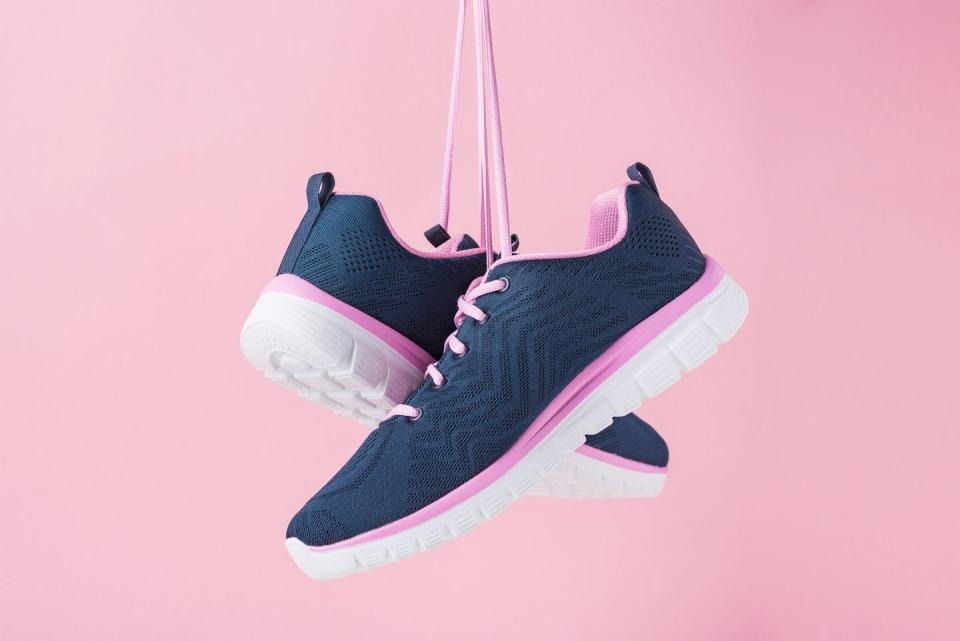Have Joint Pain? Try These 6 Exercises to Stay in Shape

Living with joint pain can make even the simplest tasks a challenge. But whether your pain is from rheumatoid arthritis or another health condition, you’ve probably learned by now that workarounds and modifications are the best way to get things done. The same goes for exercise.
It’s easy to assume that taking a pass on physical activity will make your joints feel better, but doctors say the opposite is true. “You have to keep moving,” says sports medicine specialist Bert Mandelbaum, M.D., an orthopedic surgeon at Cedars-Sinai Kerlan-Jobe Institute in Los Angeles. “Motion is lotion for your joints.” Meaning the more your joints move, the more synovial fluid they produce. They need this natural lubrication to be healthy and functional (and ultimately, to cause you less pain).
Of course, some exercises are better for joint pain than others. Going out for a long run, for example, will likely only contribute to wear and tear on your joints. But taking a stroll won’t have the same effect. In general, low-impact exercises like walking and swimming stimulate your joints without overstimulating them, says Mark Slabaugh, M.D., a sports medicine surgeon at Baltimore’s Mercy Medical Center. The result: You’ll feel better with low-impact exercise and you’ll get to remain active. It’s a win-win.
If your joint pain is extreme, it’s a good idea to consult a movement specialist like a physical therapist or your doctor before starting a new exercise routine. But for most people who live with joint pain, these doctor-approved low-impact exercises are good options to try.
1. Yoga and Pilates
Yes, yoga and Pilates are two different forms of exercise, but they have similar qualities that make them ideal for people with joint pain. These workouts are some of the best you can do with joint pain because they’re low-impact and they encourage movement,” says orthopedic surgeon Timothy Gibson, M.D., medical director of the MemorialCare Joint Replacement Center in Fountain Valley, California. “You get a lot of strength-building out of yoga and Pilates and they also burn calories.” You can start out by taking a class or using an app or even a YouTube video to find a practice that’s right for you.
2. Walking

Again, running isn’t a good option for people with joint pain because the impact increases joint stress, says Nancy R. Kirsch, Ph.D, vice chair of rehabilitation and movement sciences at Rutgers University. But walking is joint friendly, she says. In fact, walking is so good for you that the Arthritis Foundation calls it one of the most important things you can do if you have arthritis. For starters, walking can help you lose weight or maintain a healthy weight, which lessens stress on your joints. Walking also works your core and legs, Dr. Gibson says, noting that it’s an easily accessible exercise routine for most people to take up. “Walking doesn’t require any special equipment or membership, and it’s easy to fit into your schedule.” If you can, aim to walk for 30 to 60 minutes a day to reap the most benefits.
3. Swimming
Swimming laps is a great option for people with joint pain. “You’re lighter when you’re in water, which makes gravity less of a factor,” says Dr. Gibson. “You can still get a great cardio workout without putting much strain on your joints. A lot of my patients swim laps.” Research has also found that swimming is good for people with joint pain. A 2017 study of 133 women with rheumatoid arthritis found that those who swam three times a week had significant improvement in their symptoms after just eight weeks. Swimming also gets high marks for being low-impact, says Dr. Mandelbaum, noting that it helps build the muscles around each of the joints. If you haven’t swum laps in a while, you can start by doing shorter sessions in the pool—15 minutes or so—and building up to longer time periods.
4. Biking
Indoor and outdoor biking is low impact and it also can “stimulate the muscles without much stress on the joints,” says Dr. Slabaugh, helping to decrease pain while stimulating motion and mobility. Biking can really help build up your quadriceps—a big perk if you tend to have bad knees. “Having strong quads acts as a shock absorber,” says Dr. Gibson, adding that biking is one of his favorite exercises for joint pain. You can try starting out slow and eventually work your way up to 30-minute sessions on the bike.
5. Elliptical Machine
An elliptical machine is considered a low-impact alternative to running and jogging, and it’s specially designed to be easy on your joints. It has a smooth rhythm, which is comfortable on achy joints, says Dr. Gibson. He likes that the machine builds muscles in your legs, which can help with knee and ankle pain. Just like with other new forms of exercise, start out slowly on the elliptical. Try a 15- to 20-minute workout on a lower-resistance setting at first, then work your way up to longer sessions, adding more resistance as you go.
6. Strength Training

One of the goals of exercising when you have joint pain is to build up the muscles around those joints, stabilizing them and leading to less pain. “Strength training can be very helpful to increase the capacity of the muscles surrounding the joints to be more effective in their job of joint protection,” says Kirsch. Strength training will look different for everyone, but learning moves to build up specific trouble areas for you can go a long way, says Dr. Gibson. (It’s a good idea to talk to a physical therapist, trainer, or your doctor before starting a new strength training routine to get some advice on how to approach it.)
You Might Also Like

